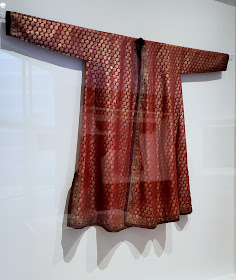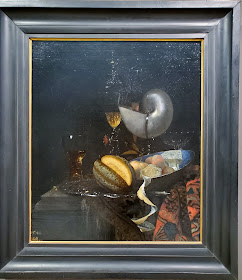Well -- we're here, let's see what we can find that has to do with fiber and make me happy. That makes sense, right?
There is a special exhibition of Carravaggio - "The Other Michaelangelo" - Martha and Mary Magdalene (c.1598). I struggle with this on so many levels, but the artistic ability cannot be denied.
Entering the permanent collection area (which I haven't been to in a long time) there is a direct descendant of Lady Godiva having her picture taken with this sculpture. How fun. Do you know about Lady Godiva? She "was an 11th-century noblewoman from Coventry, England. She is best remembered for her legendary protest against her husband's excessive taxation of his subjects, when she supposedly rode a horse through town naked. Most images of Godiva depict her famous ride, but this sculpture focuses on her moment of decision, underscoring her compassion for her subjects. She has started removing her belt, but her gaze is directed upward, recalling traditional representation of saints and holy figures." This work is by Anne Whitney.
As I'm looking at the sculpture, Mister is calling me around the corner. He has discovered a quilt!!!!
 It is a Baltimore, Maryland, "Album" quilt, c. 1861 made by Martha E. Keech. I want to make one of these but they scare me to death. I also learned a bit about the history of these quilts - "named for their prevalence in the Atlantic seaport and their resemblance to keepsake albums, they form an important moment in American textile history during a period which manufactured - rather than homespun - fabrics appeared with increasing regularity.
It is a Baltimore, Maryland, "Album" quilt, c. 1861 made by Martha E. Keech. I want to make one of these but they scare me to death. I also learned a bit about the history of these quilts - "named for their prevalence in the Atlantic seaport and their resemblance to keepsake albums, they form an important moment in American textile history during a period which manufactured - rather than homespun - fabrics appeared with increasing regularity. They are readily identified by the use of a a grid of decorative elements and a simple red and green color scheme inspired by textiles of German immigrant communities in nearby Pennsylvania. While most 'Album' quilts were produced by several hands with various levels of competency, the regularity of this example suggests a single quilter. With a running vine border, this quilt incorporates plain fabrics in red, green, orange, and yellow that are padded or stuffed in a technique called trapunto. Motifs include the common rose wreath, flowerpot, tulip cross, and bible, all rendered in a direct manner that provides the quilt with unexpected and powerful visual clarity."
"This exhibition of works from India, Central Asia, China, and Japan illustrates the way in which luxury textiles formed an important part of trade along the Silk Road."
A bedding cover (futonji) from Japan: late 19th century. Made of cotton and resist dyed.
Close up of the edging.
The next room is filled with fiber and textiles from Indonesia. If you are in the metroplex, check it out.
This one is a sacred textile (mawa) and is from Indonesia: South Sulawesi, Sa'dan Toraja people 19th century or early 20th century. Homespun cotton, stamped and painted. "The female figure within the central rondel of this textile is the goddess Indo' Samadenna (Mother All There Is), depicted with a golden spinning wheel she won in a quarrel with her sister and brought to the moon. The companionable rooster stands guard as the goddess guides the wheel and pulls at the thread. Above her are the seven stars of Bunga', whose place in the sky determines the beginning of the agricultural cycle. The row of stars beneath her spinning wheel represents Orion's belt, known to the Toraja as the Rice-bearer. The cloth's wide field at either side of the rondel is divided by two lines representing irrigation channels that bring water to the rice fields. Together, all the motifs bring good fortune or blessings, especially to women."




















No comments:
Post a Comment